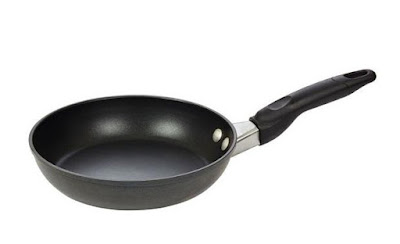Tip 6 - Skip the non-stick to avoid the dangers of Teflon
Non-stick cookware has been popular because, well, it's non-stick -- very convenient to use and clean. But it also emits toxic fumes when overheated. Environmental Working Group recommends that you choose safer cookware to reduce the risk of inhaling toxic particles when you let that non-stick pan get a little too hot.
- Why you should skip the non-stick
- What safer cookware to choose
- How to cook with non-stick if you're 'stuck' with it
- Other ways people are exposed to PFCs, and how to avoid them
WHY YOU SHOULD SKIP THE NON-STICK
Non-stick surfaces are metal pans (such as aluminum pans) coated with a synthetic polymer called polytetrafluoroetheylene (PTFE), also known as Teflon, a DuPont brand trademark. Learn more about Teflon and its perfluorinated chemical “family” (PFC’s) in our chemical dictionary.
Toxic fumes from the Teflon chemical released from pots and pans at high temperatures may kill pet birds and cause people to develop flu-like symptoms (called "Teflon Flu" or, as scientists describe it, "Polymer fume fever"). Ingesting particles that flake off scratched non-stick cookware isn't toxic because solid PTFE flakes are inert.
Manufacturers' labels often warn consumers to avoid high heat when cooking on Teflon. But EWG-commissioned tests conducted in 2003 showed that in just two to five minutes on a conventional stove top, cookware coated with Teflon and other non-stick surfaces could exceed temperatures at which the coating breaks apart and emits toxic particles and gases.
See a graphic of what happens at to Teflon at various temperatures.
Health dangers: When you breathe kitchen air polluted with fumes from overheated Teflon, you're at risk for developing flu-like symptoms (yes, "Teflon flu"). The long-term effects of routine exposure to Teflon fumes, and from Teflon flu itself, have not been adequately studied.SAFER POTS, PANS AND BAKEWARE ARE READILY AVAILABLE
PFCs have been found in nearly all Americans tested by federal public health officials. Chemicals from this family are associated with smaller birth weight and size in newborn babies, elevated cholesterol, abnormal thyroid hormone levels, liver inflammation and weakened immune defense against disease.
Environmental hazards: Manufacturing PFCs and the consumer products that contain them poses great risks to the environment and wildlife. The U.S. Environmental Protection Agency says PFCs present "persistence, bioaccumulation, and toxicity properties to an extraordinary degree."
While there are a growing number of new cookware options on the market, we don't know enough about them to know if they're safe -- even if they're advertised as "green" or "not non-stick." We continue to recommend cast iron and stainless steel cookware as safer options for stove-top cooking, and oven-safe glass for baking. These safer pans might be a little harder to clean, but your health is worth it.
Stainless steel is a terrific alternative to a non-stick cooking surface. Most chefs agree that stainless steel browns foods better than non-stick surfaces.
Cast iron remains a great alternative to non-stick cooking surfaces. Lodge, America's oldest family-owned cookware manufacturer, refers to its cookware as "natural non-stick." Cast iron is extremely durable and can be pre-heated to temperatures that will brown meat and will withstand oven temperatures well above what is considered safe for non-stick pans.
HOW TO COOK WITH NON-STICK IF YOU'RE 'STUCK' WITH IT
- Never preheat nonstick cookware at high heat -- empty pans can rapidly reach high temperatures. Heat at the lowest temperature possible to cook your food safely.
- Don't put nonstick cookware in an oven hotter than 500 degrees.
- Use an exhaust fan over the stove.
- Keep pet birds out of the kitchen -- the fumes from an overheated pan can kill a bird in seconds.
- Skip the self-cleaning function on your oven. It cleans by heating to high temperatures, which can release toxic fumes from non-stick interior oven parts.
- Choose a safer alternative when buying new cookware.
